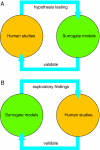Lesch-Nyhan disease: from mechanism to model and back again
- PMID: 19259384
- PMCID: PMC2650214
- DOI: 10.1242/dmm.002543
Lesch-Nyhan disease: from mechanism to model and back again
Abstract
Lesch-Nyhan disease (LND) is a rare inherited disorder caused by mutations in the gene encoding hypoxanthine-guanine phosphoribosyltransferase (HPRT). LND is characterized by overproduction of uric acid, leading to gouty arthritis and nephrolithiasis. Affected patients also have characteristic neurological and behavioral anomalies. Multiple cell models have been developed to study the molecular and metabolic aspects of LND, and several animal models have been developed to elucidate the basis for the neurobehavioral syndrome. The models have different strengths and weaknesses rendering them suitable for studying different aspects of the disease. The extensive modeling efforts in LND have questioned the concept that an 'ideal' disease model is one that replicates all of its features because the pathogenesis of different elements of the disease involves different mechanisms. Instead, the modeling efforts have suggested a more fruitful approach that involves developing specific models, each tailored for addressing specific experimental questions.
Figures


Similar articles
-
Transcriptomic approach to Lesch-Nyhan disease.Nucleosides Nucleotides Nucleic Acids. 2014;33(4-6):208-17. doi: 10.1080/15257770.2014.880477. Nucleosides Nucleotides Nucleic Acids. 2014. PMID: 24940671 Free PMC article.
-
The biochemical basis of the neurobehavioral abnormalities in the Lesch-Nyhan syndrome: a hypothesis.Med Hypotheses. 2004;63(1):131-4. doi: 10.1016/j.mehy.2004.01.019. Med Hypotheses. 2004. PMID: 15193365
-
Genotypic and phenotypic spectrum in attenuated variants of Lesch-Nyhan disease.Mol Genet Metab. 2014 Aug;112(4):280-5. doi: 10.1016/j.ymgme.2014.05.012. Epub 2014 May 28. Mol Genet Metab. 2014. PMID: 24930028 Free PMC article. Review.
-
Molecular, biochemical, and genetic characterization of a female patient with Lesch-Nyhan disease.Mol Genet Metab. 2006 Mar;87(3):249-52. doi: 10.1016/j.ymgme.2005.09.025. Epub 2005 Dec 15. Mol Genet Metab. 2006. PMID: 16343967
-
Inherited deficiency of hypoxanthine-guanine phosphoribosyltransferase in X-linked uric aciduria (the Lesch-Nyhan syndrome and its variants).Adv Hum Genet. 1976;6:75-163. doi: 10.1007/978-1-4615-8264-9_2. Adv Hum Genet. 1976. PMID: 779428 Review. No abstract available.
Cited by
-
Lesch-Nyhan Syndrome in an Indian Child.Indian J Dermatol. 2015 May-Jun;60(3):298-300. doi: 10.4103/0019-5154.156392. Indian J Dermatol. 2015. PMID: 26120162 Free PMC article.
-
Consequences of impaired purine recycling on the proteome in a cellular model of Lesch-Nyhan disease.Mol Genet Metab. 2015 Apr;114(4):570-579. doi: 10.1016/j.ymgme.2015.02.007. Epub 2015 Mar 5. Mol Genet Metab. 2015. PMID: 25769394 Free PMC article.
-
A modified TALEN-based system for robust generation of knock-out human pluripotent stem cell lines and disease models.BMC Genomics. 2013 Nov 9;14:773. doi: 10.1186/1471-2164-14-773. BMC Genomics. 2013. PMID: 24206569 Free PMC article.
-
Erosion of dosage compensation impacts human iPSC disease modeling.Cell Stem Cell. 2012 May 4;10(5):595-609. doi: 10.1016/j.stem.2012.02.014. Cell Stem Cell. 2012. PMID: 22560080 Free PMC article.
-
Human de novo purine biosynthesis.Crit Rev Biochem Mol Biol. 2021 Feb;56(1):1-16. doi: 10.1080/10409238.2020.1832438. Epub 2020 Nov 12. Crit Rev Biochem Mol Biol. 2021. PMID: 33179964 Free PMC article. Review.
References
-
- Bitler CM, Howard BD. (1986). Dopamine metabolism in hypoxanthine-guanine phosphoribosyltransferase-deficient variants of PC12 cells. J. Neurochem. 47, 107–112 - PubMed
-
- Breese GR, Knapp DJ, Criswell HE, Moy SS, Papadeas ST, Blake BL. (2004). The neonate 6-hydroxydopamine lesioned rat: a model for clinical neuroscience and neurobiological principles. Brain Res. Rev. 48, 57–73 - PubMed
-
- Connolly GP, Duley JA, Stacey NC. (2001). Abnormal development of hypoxanthine-guanine-phosphoribosyltransferase-deficient CNS neuroblastoma. Brain Res. 918, 20–27 - PubMed
Publication types
MeSH terms
Substances
Grants and funding
LinkOut - more resources
Full Text Sources
Miscellaneous

